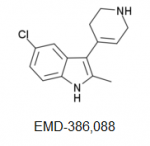nuke
Bluelighter
- Joined
- Nov 7, 2004
- Messages
- 4,191
EMDT is a standard agonistic ligand for the 5-HT6 receptor; it is known that this receptor serves to function somehow in the auditory system.
2-Me-DMT, 2-Me-DET, and DiPT are all effective disturbers of the auditory system in humans, with DiPT being the most potent.
EMD-386,088 is an extremely potent agonist at the 5-HT6 receptor.
My thoughts are that strong agonists for this receptor (and thus auditory system distortion) have hydrophic regions:
1.) Between the non-cyclic amine in tryptamine and the pyrroline ring.
2.) At the 2-position of the tryptamine, extending outward.
With the free rotation of the alkylamine "tail" in DiPT, it could meet both of these proposed specifications well (whereas DPT could be hindered by interactions/conformations with the receptor).
I would be hopeful that human assays of either EMDT or EMD-386,088 might produce an effect of auditory distortion.
2-Me-DMT, 2-Me-DET, and DiPT are all effective disturbers of the auditory system in humans, with DiPT being the most potent.
EMD-386,088 is an extremely potent agonist at the 5-HT6 receptor.
My thoughts are that strong agonists for this receptor (and thus auditory system distortion) have hydrophic regions:
1.) Between the non-cyclic amine in tryptamine and the pyrroline ring.
2.) At the 2-position of the tryptamine, extending outward.
With the free rotation of the alkylamine "tail" in DiPT, it could meet both of these proposed specifications well (whereas DPT could be hindered by interactions/conformations with the receptor).
I would be hopeful that human assays of either EMDT or EMD-386,088 might produce an effect of auditory distortion.





